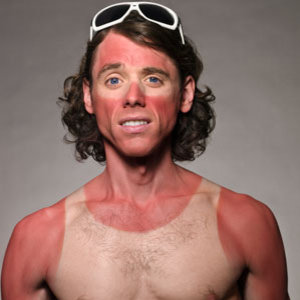 |
| His novel way around 'No shirt, no service' was not a success. |
As the Javelin sped towards St. Pancras on the eleventh day of the Paralympics, Tom turned to me and casually uttered the most feared words in the language of pasty people: “I think you’ve got sunburnt.” I followed his gaze, and to my horror he was right; a pale, bra-strap sized strip ran through a very red-looking patch of shoulder.
Like all fair-skinned people, I have waged a battle with
the sun for as long as I can remember. On childhood holidays, my enviably
dark-skinned cousins would swim with cheerful abandon in sunny Spanish rays,
while my mum was pinning me down and applying Factor 30, a large t shirt and a
pair of swimming trunks over my swim suit. And even then I would probably
emerge from the pool red-cheeked, red-shouldered and seeing red.
For many pasty people, sunburn is as much a part of
British summer as Wimbledon, rain and barbeques. The moment the sun appears, we
join everyone else in a desperate beeline for it, knowing that this may be our
only chance to transform from TB victims in a period drama to the bronzed
beauties seen lounging elegantly in Mediterranean cafés.
However, in the rush for that last piece of sun drenched
grass, many choose to forget that we are putting our poor, melanin-deprived
skin in danger. While basking in warm rays after months of grey skies and icy
winds initially feels like the greatest idea since Ben approached Jerry with a
crazy suggestion, we may regret it later. Pale-skinned people don’t produce enough
melanin pigment (which absorbs UV) to provide protection from the sun, which
means that we go straight from pale to crimson. On the day in question, I had
faithfully reapplied my SPF 20 three times, yet still those fateful rays got
through. It can take between 12 to 24 hours for the effects of sunburn to show,
at which point no amount of After Sun and regret will repair the damage
inflicted on our cells.
That’s not to say that those golden glows are necessarily
a safe reaction to the sun. A tan has long been hailed as a sign of good
health, even before the first ‘sun clinic’ popped up in 1903, promising
visitors numerous health benefits. The tan’s popularity was further secured
when style goddess Coco Chanel stepped off a beach in the Riviera in 1923 with
an accidental tan. However, that deep, long-lasting tan is actually your body’s
version of damage control, induced by UVB rays penetrating and damaging skin
cells and causing the pituitary to release a hormone that increases melanin
production. Even cells belonging to those lucky people with a naturally high
level of melanin pigment can be damaged by the sun, although this is far less
likely than in paler people.
Thankfully, our knowledge of sun safety has come a long
way. During a recent conversation with my mum and grandma on one of our more
scorching days this summer, I discovered that sunburn used to be seen as simply
a painful nuisance that must be battled through in order to attain golden
perfection. A walk along a beach or park would reveal people of all ages whose
skin was so badly burned that the layers of damage would be visible to the
naked eye. Although seen as acceptable back then, this would now, as mum suggested,
be viewed as child abuse.
Even at a less extreme level, sun care is gradually
working its way into public consciousness. Dermatologists recommend wearing sunscreen
with a minimum of SPF 15 all year round, since those devilish UVA and UVB rays
can penetrate clouds, and this is now included in an increasing number of
beauty products, including body lotions, moisturisers and BB creams. While this
is obviously good news for our skin cells, it can also be beneficial on a
superficial level, with sunscreen proven to be the most effective way of delaying
the appearance of aging.
This is not to suggest that we must throw away our
bikinis, brick up our windows and never venture outside again. UVB rays allow
our bodies to synthesise vitamin D, which is important for bones, the intestine,
and, as any sun-starved Brit will tell you, stress levels. So by all means,
elbow your way into that last patch of September sun, but make sure you protect
your skin.
No comments:
Post a Comment